Yamaha’s Open-class WR offers snappy power, crisp handling and a lot of bang for the buck
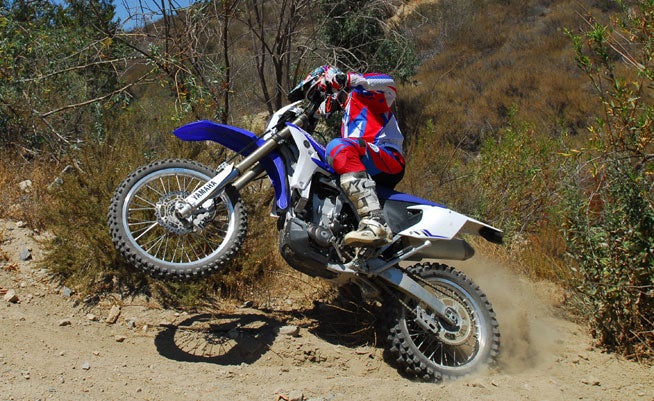
It’s no wonder that most dirtbike riders tend to associate European brands with state-of-the-art Open-class off-road racing motorcycles. After all, the vast majority of KTM sales are in the off-road market, Husqvarna has been on a slow but steady climb back into prominence, and smaller yet no less dynamic companies such as trials bike giants Beta and Gas Gas have devoted a lot of time and resources into manufacturing excellent big-bore off-road bikes.
But while only two of the Big Four manufacturers—Yamaha and Honda—sell competition-ready off-road machines, Yamaha’s WR450F is are far from just a token entry in the market. Thanks to constant refinement over the years, the WR450F combines YZ motocross-style power in a lightweight, 250F-derived chassis with awesome handling. If you’re an off-road racer seeking an alternative to an expensive European machine, Big Blue may have the bike for you.
For the most part, the WR450F’s history parallels that of its YZ450F sister, beginning life in the late 1990s as a 400cc machine before being bumped in displacement to 426cc and then to its current 450cc engine size. Along the way, the WR has received numerous technical improvements learned from Yamaha’s YZ and WR race programs, and while the latest-generation WR450F still isn’t powered by a version of the YZ’s forward-positioned, rear-inclined cylinder power plant, its liquid-cooled 449cc DOHC four-stroke engine delivers the right kind of power for any off-road condition.
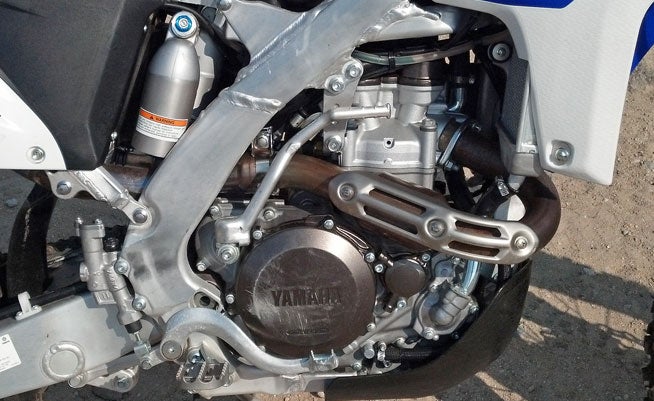
Yamaha significantly improved the WR in 2012 by ditching its antiquated carburetor in favor of electronic fuel-injection. The benefits were numerous, including better throttle response and easier power tuning via adjustments to the ECU. But perhaps most importantly, the EFI made the WR450F EPA- and CARB-certified, meaning that it can be ridden on public OHV lands in all 50 states. The WR450F engine utilizes a dry-sump oiling system (the new YZ450F is a wet sump), but the oil is still carried in a reservoir inside the engine cases for mass centralization purposes.
Swing a leg over the WR450F, and the first thing you’ll appreciate is its handy electric start feature. Not that the WR is a hard to light off with its “accessory” kickstart lever, but for inseam-challenged riders or vets, less energy spent kicking equals more energy spent riding. Once the WR settles into an idle, you’ll also notice how smoothly it runs. Yamaha engineers worked on reducing vibration by paying careful attention to the WR’s crank balance in conjunction with the AC generator that powers the WR’s lighting system to quell harsh vibration. The WR isn’t a sewing machine, but it is definitely emits less vibration than a YZ.
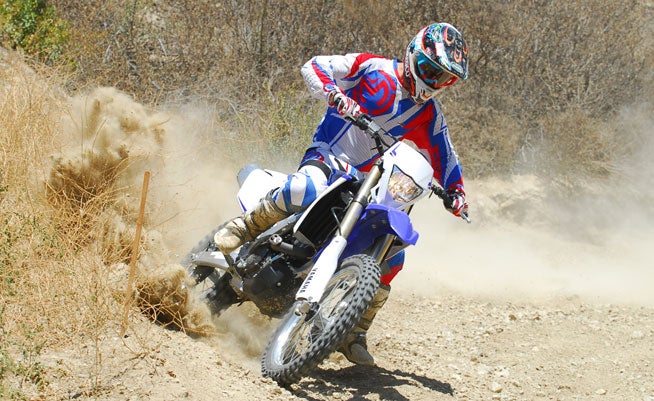
Out on the trail, the WR’s five-valve motor’s power curve is broad and muscular, and its YZ roots are evident in the form of a snappy delivery. Compared to the Honda CRF450X that we tested earlier this season, the WR feels racier, with a more robust mid-range and top-end lunge, but it is also less tractable, and we found that some of our favorite technical off-road sections that were manageable with careful throttle management on the Honda to maintain steady traction required more concentration on the Yamaha. While its fuel-injection and digital TCI ignition combine to keep the power crisp with a linear throttle response, the WR’s quick-revving engine feels like has less flywheel mass than the Honda, and it’s willing to break traction sooner.
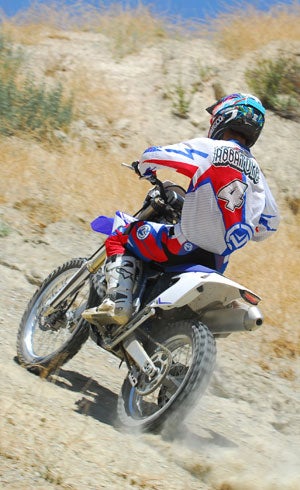
That said, it take little more than a finger on the WR’s light and smooth clutch to keep rear wheel spin in line, and when traction is abundant, the WR has plenty of oomph. However, there are ways to really unleash the beast in the WR for improved closed-course racing performance. Removing the restrictive baffle in the WR’s repackable, USFS-approved aluminum muffler will allow the engine to breathe better, and swapping to a YZ throttle housing from the same year does away with the throttle stop required to help the WR meet emissions, unleashing even more power.
Buzzing through the gears of the WR’s wide-ratio five-speed transmission reveal an acceptable shift quality. It isn’t as smooth as some of its competition’s, but we never missed a shift while riding the WR. The transmission ratios are spaced perfectly, with a low gear that can allow the rider to tackle tight terrain, such as when picking through tight woods or over rocks. And if you should find that you need to make a clutch adjustment when torturing the WR through gnarly, endure-like low-speed sections, the clutch lever features an oversize barrel adjuster for on-the-fly adjustability of lever/cable play.
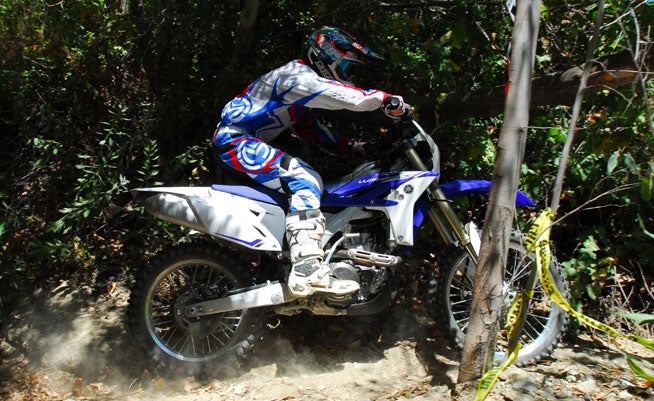
Despite a claimed wet weight of 273 lbs., the WR450F feels light and flickable on the trail at high or low speeds. It’s no feather, but its YZ250F-bred aluminum perimeter frame—a mix of castings, forgings and extrusions that comprise the main frame and a removable aluminum rear subframe constructed of square-section tubing—helps the big WR feel much smaller and lighter than it is. Yamaha has clearly done a good job of getting all that weight where it doesn’t hinder the WR’s steering. Our testing included every type of terrain from hard-packed fire roads to sandy, wooded single track, and we never found ourselves wanting more steering precision. At high speed, the WR’s 57.7-inch wheelbase helps keep it as stable as an arrow, yet it is willing to change directions more quickly than a CRF450X.
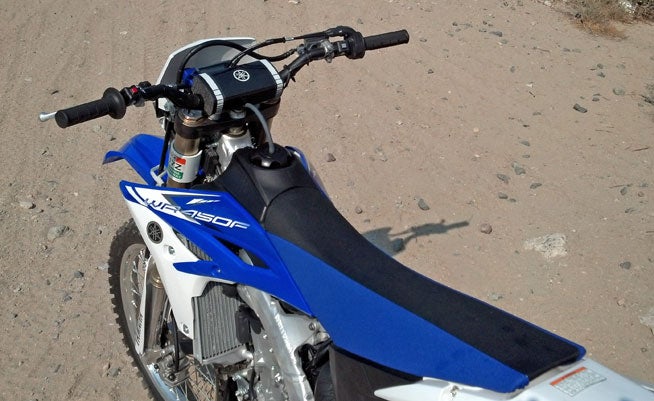
The WR450F’s slim and flat ergonomic feel also help handling. The layout allows the rider to move freely about the cabin when negotiating nasty terrain and maintain good leverage on the WR’s tapered aluminum handlebar. And while it is slim through the middle, the WR’s seat padding offers plenty of comfort when the rider is seated. We also appreciate that Yamaha’s effort to keep the WR’s 2.1-gallon fuel tank and radiator shrouds slim despite the use of large-capacity radiators necessary to keep the high-revving WR from blowing its top in slow terrain where cooling air into the radiators is at a premium.
 Your Privacy Choices
Your Privacy Choices